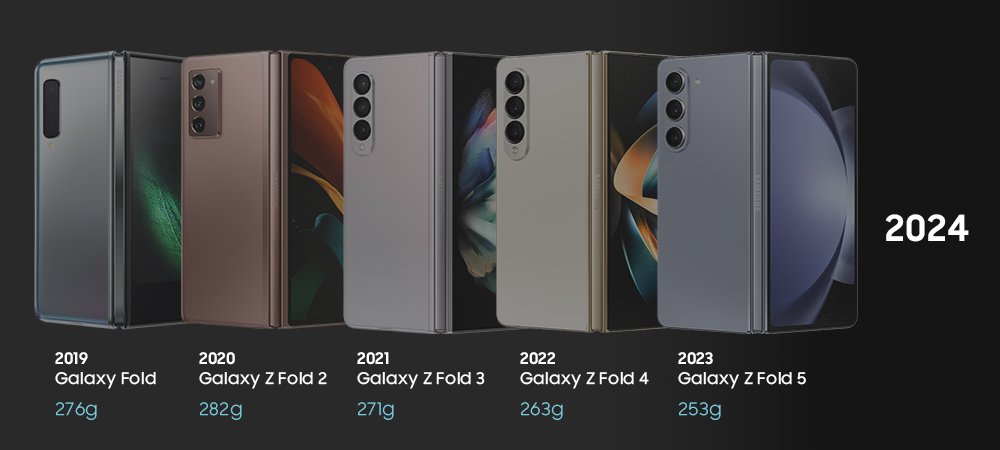
A foldable is exactly that — a folding phone. Unlike bar-type smartphones with a single body, foldables consist of a central hinge and two folding sides. The hinge serves as the central axis for opening and closing the phone. Over time, Samsung has introduced unique, cutting-edge technology into the hinge mechanism of its Galaxy Z Fold series to create a revolutionary hinge design with each release. In addition, Samsung has continued to reduce the thickness of the Galaxy Z Fold series so the phone can be carried anytime, anywhere.
Samsung Newsroom looked back at the evolution of the Galaxy Z Fold series’ sleek profile and distinctive hinge design — now thinner, sturdier and compact as ever.
[2019] Galaxy Fold
The Dawn of Foldable Phones: Folding and Unfolding
Thickness when folded: 15.7-17.1mm Thickness when unfolded: 6.9-7.6mm Weight: 276g
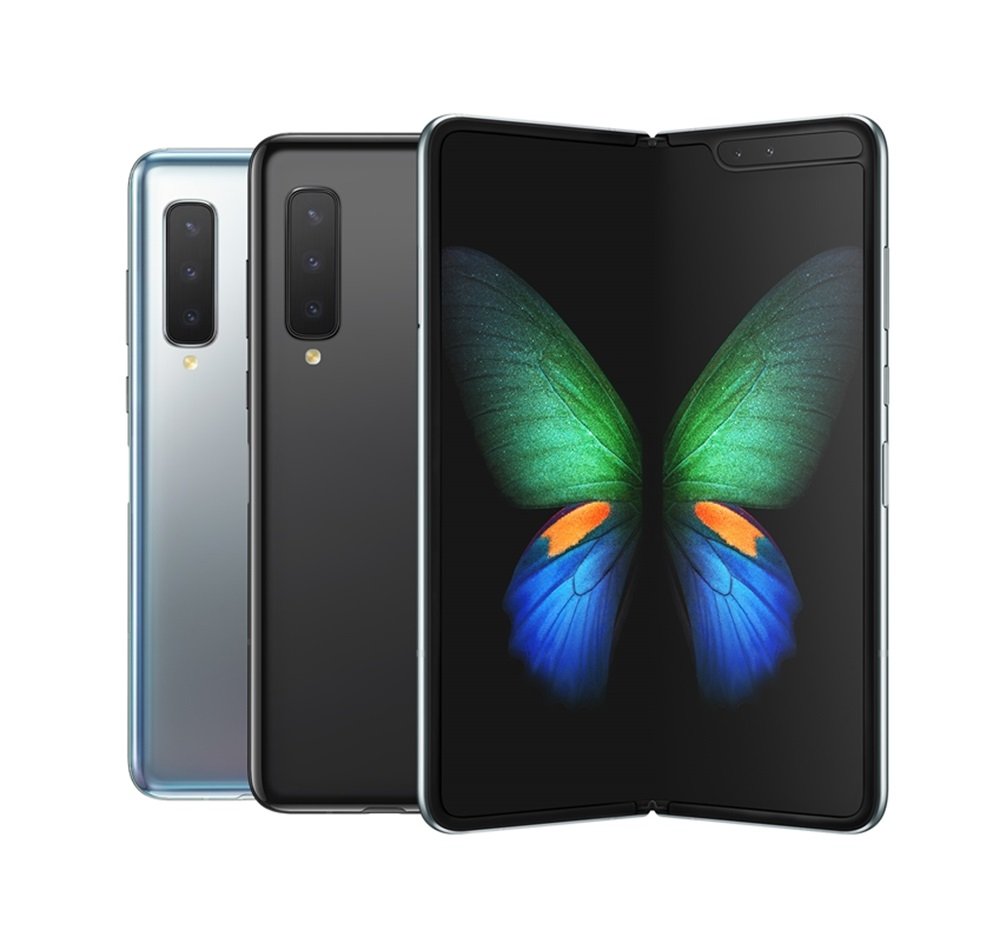
As user lifestyles continue to diversify, so too do their needs. Samsung has consistently introduced advanced technologies each year to meet these changes. First unveiled in 2019, the Galaxy Fold featured a groundbreaking form factor — the first to deliver a natural, big-screen experience when unfolded and a compact, portable experience when folded. The act of “folding and unfolding” emerged as a new category of mobile interaction, and Samsung applied never-before-seen hinge technology to ensure this functionality felt natural and intuitive.
The inward-folding hinge not only felt familiar and easy to use, but it also provided robust display protection. The phone could be smoothly opened like a book, yet stay flat and thin when folded. The palm-sized dimensions were key to its convenience. With the first Galaxy Fold, Samsung achieved a maximum folded thickness of just 17.1 millimeters and ushered in the era of smart foldables.
[2020] Galaxy Z Fold2
The Era of Flex Mode: Hideaway Hinge and Sweeper Technology
Thickness when folded: 13.8-16.8mm Thickness when unfolded: 6.0-6.9mm Weight: 282g
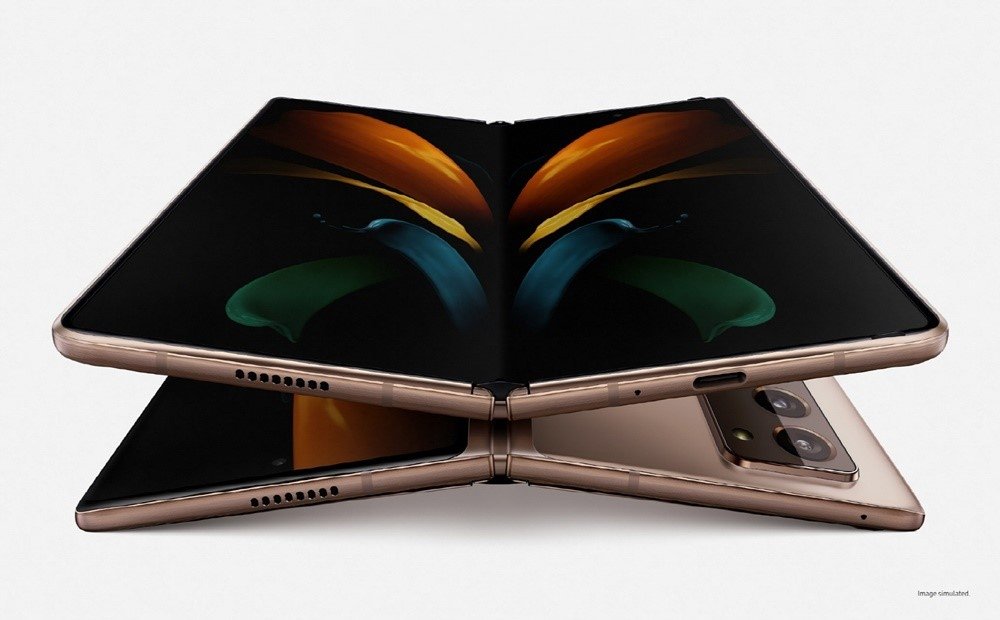
In 2020, the successor to the pioneering Galaxy Fold was released. The Galaxy Z Fold2 took foldables to the next level with an all-new sophisticated and refined design. The most notable of its several innovative features was the Hideaway Hinge, which seamlessly connected the body of the smartphone while supporting stable folding and unfolding. Users could mount the Galaxy Z Fold2 at various angles with the Hideaway Hinge to easily take selfies and make video calls in Flex Mode.
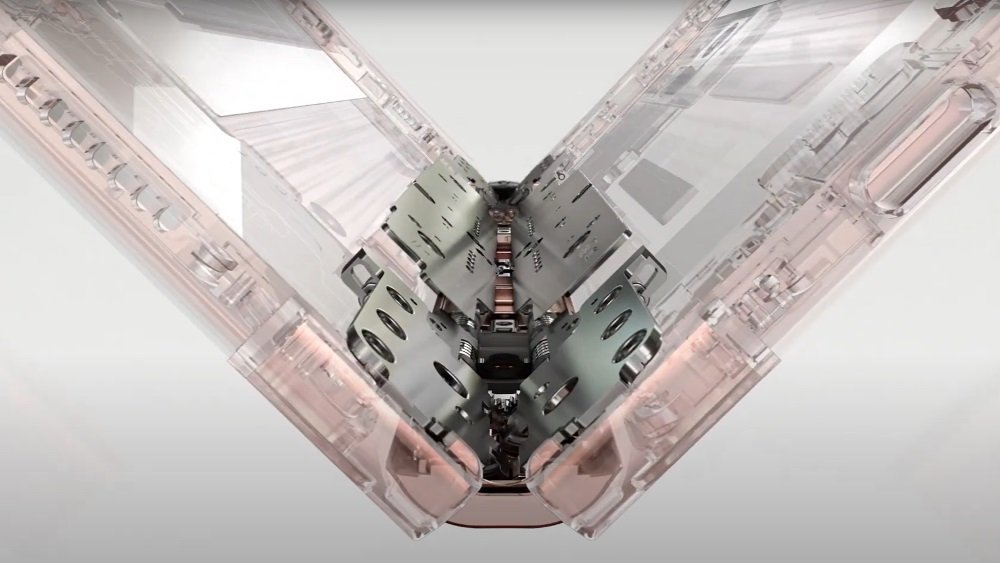
The Hideaway Hinge’s more than sixty parts made the innovative dual CAM mechanism a reality. The flat surface between two ridge-shaped parts, CAM helped keep the device open or closed and enabled Flex Mode. By increasing the number of CAM structures and springs, the hinge could reliably support wider angles. The Hideaway Hinge was mounted on an optimal location on the Galaxy Z Fold2 for an even slimmer design and a maximum folded thickness of just 16.8 millimeters.
Since the hinge was constantly folded when the device was opened or closed, there was an inevitable gap between the front of the device and the hinge housing. To effectively minimize this gap, Samsung needed to develop a component that would be long-lasting and elastic without adding extra bulk. Inspired by the brush of a vacuum cleaner, Samsung made use of delicately cut optical fibers to address this issue: Sweeper Technology. Sweeper Technology protected the phone’s display from external dust and debris that could enter through the gap , providing a more fluid foldable device experience.
[2021] Galaxy Z Fold3
The Solution to the Foldable Phone’s Biggest Challenge: Waterproofing
Thickness when folded: 14.4-16.0mm Thickness when unfolded: 6.4mm Weight: 271g
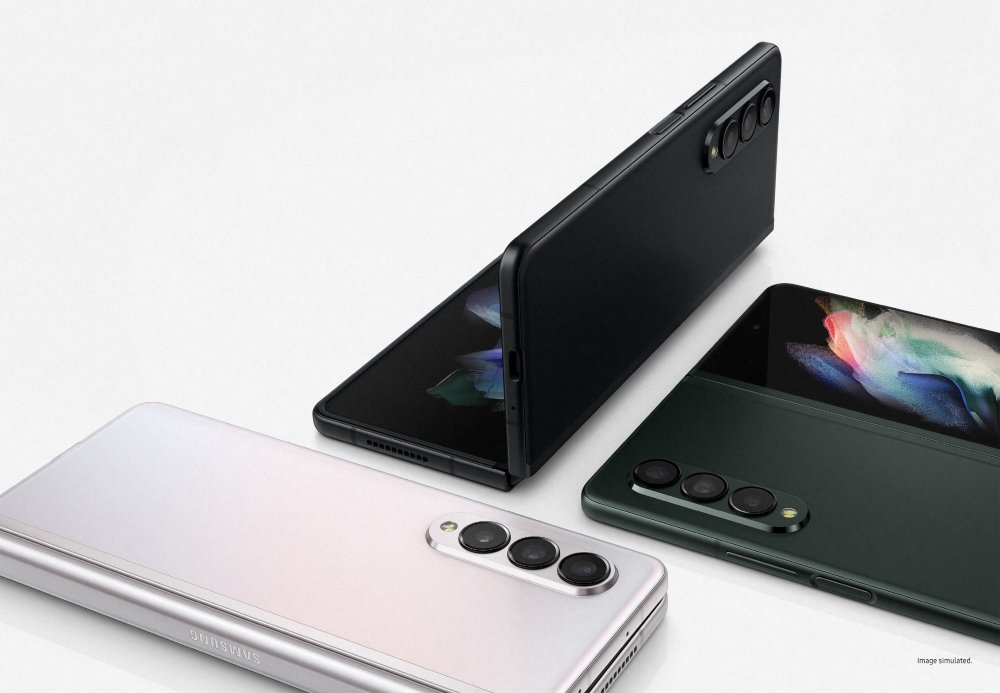
It’s a given that today’s smartphones are waterproof. However, the hinge that opened and closed the screen on foldables would always be exposed to the elements. If liquids such as beverages or even rainwater leaked inside, the device would be at risk of immediate malfunction.
The Galaxy Z Fold3 was the first foldable to be water resistant, one of the biggest challenges that previous foldable devices faced. Samsung’s waterproofing technology was applied to two areas — the outer part of the display and the hinge. The outer part of the display was surrounded by a rubber band that prevented dust and liquid from entering, whereas the metal parts of the hinge were made of corrosion-resistant materials and coated with a long-lasting lubricant. The terminal connecting the two mainboards bordering the hinge was sealed with a silicone-based cured-in-place gasket (CIPG) that prevented liquid from entering the device. Additionally, flexible printed circuit board (FPCB) cables were used to protect sensitive components.
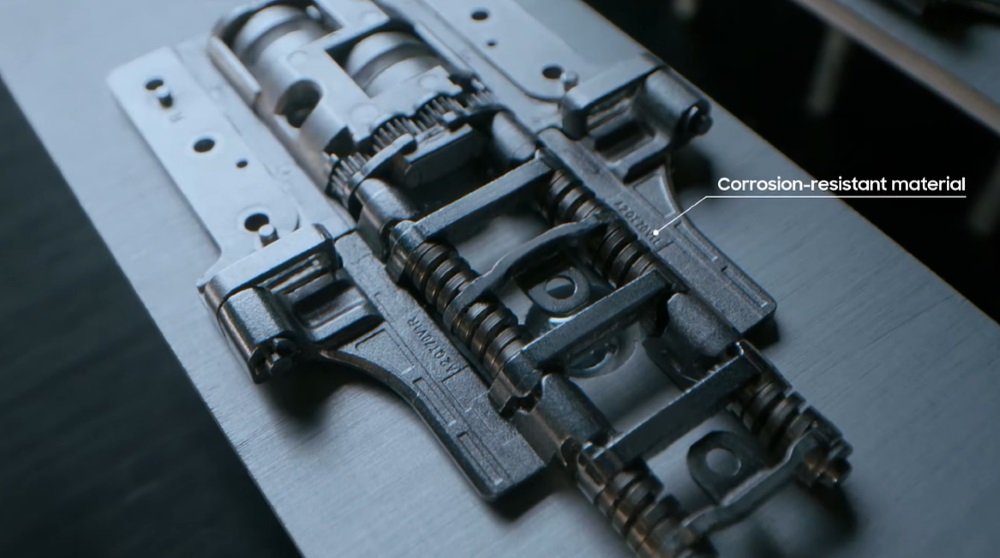
A robust material that withstands external shocks and reduces the risk of deformities or scratches, Armor Aluminum was used to help the Galaxy Z Fold3 achieve an even thinner and lighter form factor.
Armor Aluminum was applied to the two edges that make up the exterior and to the housing that surrounds the hinge. Various components were densely packed inside the Galaxy Z Fold3’s Hideaway Hinge to enable Flex Mode and ensure smooth opening and closing. To support these functions, the hinge housing needed to be made from sturdy materials.
The Sweeper Technology that closed the gap between the hinge and the body of the foldable evolved too. As the device became slimmer, the sweeper’s bristles were shortened to improve aesthetics while still keeping the hinge safe from dust and external particles. These innovations allowed the Galaxy Z Fold3 to be as thin as 16.0 millimeters when folded.
[2022] Galaxy Z Fold4
From Rotating to Linear: A Slimmer, Lighter Hinge
Thickness when folded: 14.2-15.8mm Thickness when unfolded: 6.3mm Weight: 263g
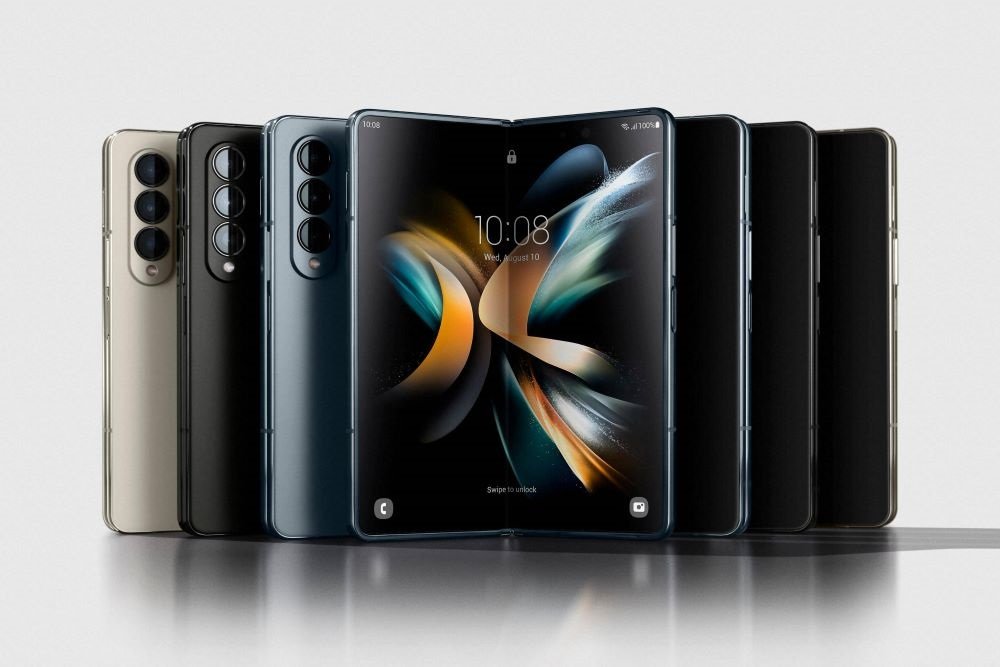
Unveiled in 2022, the Galaxy Z Fold4 saw a significant reduction in weight and thickness. At 263 grams, the device weighed nearly 20 grams less than the Galaxy Z Fold2 at 282 grams. The maximum folded thickness was 15.8 millimeters, making this foldable the thinnest in the series at the time. Once again, Samsung loaded its signature foldable with innovation — resulting in an easy-to-grip, thin and lightweight body.
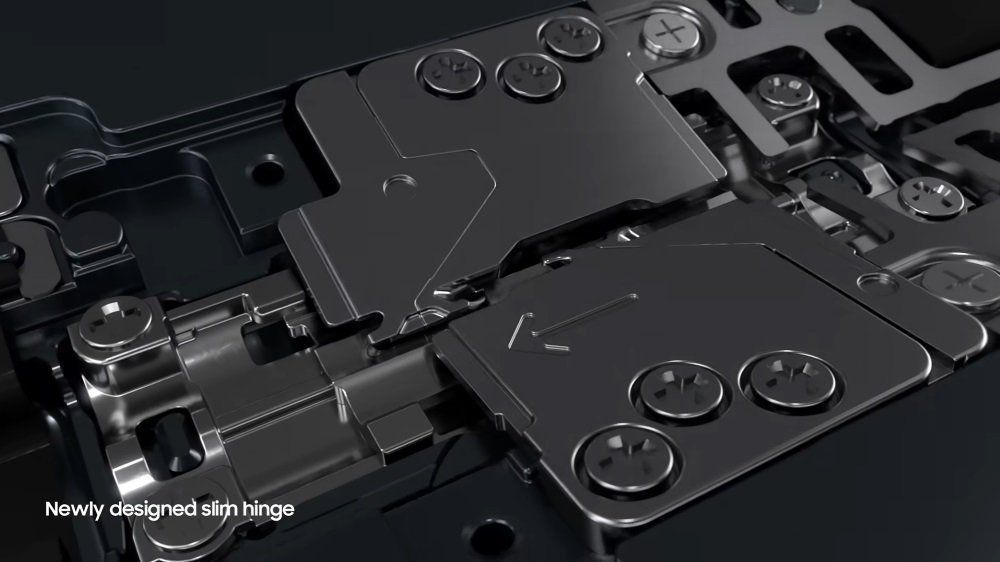
Redesigned to be 21% lighter than its predecessor, the new hinge of the Galaxy Z Fold4 accommodated the wider width and shorter length of the Cover Screen. While the previous foldable in the series used interlocking gears to ensure even screen folding and unfolding, the Galaxy Z Fold4 changed the hinge motion from rotary to linear. This adjustment drastically reduced weight, thickness and the number of parts, which streamlined manufacturing and improved the device’s resilience. With the Galaxy Z Fold4, Samsung built its slimmest, lightest hinge at the time while upholding the same level of durability as the previous form factor.
[2023] Galaxy Z Fold5
Flex Hinge: The Secret to a Fully Foldable Phone
Thickness when folded: 13.4mm Thickness when unfolded: 6.1mm Weight: 253g

In 2023, the Galaxy Z Fold5 introduced the world to the next generation of foldable smartphones. Moving away from the traditional Hideaway Hinge, Samsung unveiled a new type of mechanism called the Flex Hinge — demonstrating a leap forward in foldable innovation. With improved flexibility and a wide range of features, the Flex Hinge made it possible for the display to curl into the hinge like a water droplet using four drive shafts and a dual rail structure that allowed parts to glide along it. Thanks to this hinge technology, the two screens could be evenly folded without any creases or gaps.
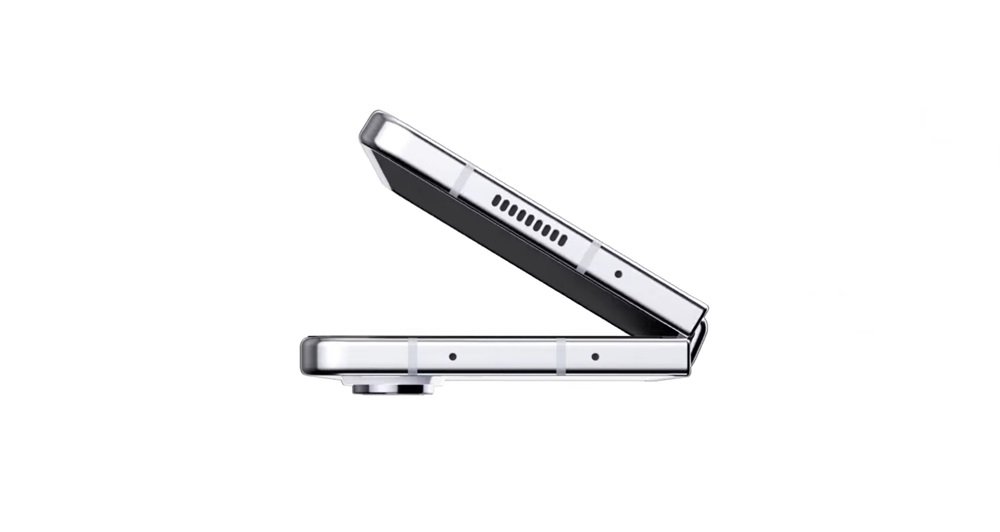
This new folding mechanism resulted in the lightest and thinnest Galaxy Z Fold series device yet. More than two millimeters thinner than its predecessor, the Galaxy Z Fold5’s maximum thickness is 13.4 millimeters when folded. The foldable also weighs 253 grams — 10 grams lighter than its predecessor — making it more compact, portable and stable when folded. The phone’s sleek, solid shape could be appreciated from any angle.
Each year, Samsung refines the Galaxy Z Fold series by leveraging precise engineering and meticulous manufacturing processes. Every detail is studied carefully, from internal mechanisms to exterior design. Reimagining the hinges and device thickness — core attributes of the foldable — has enhanced the utility of the Galaxy Z Fold series immensely. Samsung will continue to build on its legacy of unprecedented foldables, ensuring that more people can utilize them for an even more convenient life.
Discover the next generation of Samsung’s innovations at Galaxy Unpacked 2024 on July 10 in Paris.
This article was first published at Source link . You can check them out for other stuffs
